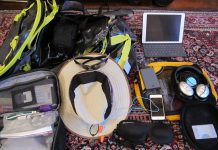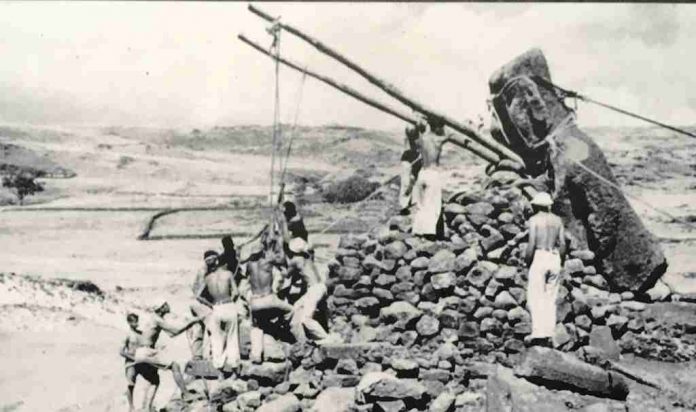When one thinks of traveling to Easter Island (known locally as Rapa Nui), the reason certainly centers around the Moai, the stone statues representing long-eared legless human (mostly) male torsos which are so plentiful across the island. What makes them intriguing is not just their artistry, but more the mystery they leave us with: how were they carved, transported and erected? The first European discovery of the island was in 1722, by the Dutch explorer Jacob Roggeveen (on Easter Sunday, hence the name). He was so puzzled by the strange statues that he wrote in his journal:
“The stone images at first caused us to be struck with astonishment, because we could not comprehend how it was possible that these people, who are devoid of heavy thick timber for making any machines, as well as strong ropes, nevertheless had been able to erect such images, which were fully 30 feet high and thick in proportion.”
Roggeveen’s ship arrived to an island with not a single tree or bush over 10 feet tall, prompting the mystery of how these islanders could manage the statues without substantial wood, wheels, and draft animals.
In the many years since then, part of the mystery has been solved… they did have substantial wood. In fact, the wood that was available to them included the largest species of palm on the planet (up to seven feet in diameter). But his detail was unavailable to Roggeveen, since it and about 15ish other tree species had gone extinct before his arrival.
Along with the moai, large stones for the ahu (platform upon which most of the moai were placed) and the pukao (hat-like stones or topknots which were placed on top of many statues) had to also be transported.
The discovery of the prior-existing palms solved part of the mystery to future explorers and anthropologists, but how the wood was used is still up for debate. The Father Sebastian Englert Anthropological Museum provides the following sketches of various theories.
Vote for your favorite theories by liking the pictures below!
Carving the Moai
Carving the Moai
Step 1
The MOAI is outlined on the Rock
.
Easter Island - Carving, Transporting & Erecting Moai
Location: Hanga Roa, Easter Island
.
Note: Many of these steps were never documented, so what is presented are various options which *may* explain the process.
These pictures were taken in the Father Sebastian Englert Anthropological Museum
.
Head to the link in my profile for more details: @mytravels.hdf
.
Picture taken: 10/2018
.
#EasterIsland #MOAI #MOAITheories #HangaRoa #FatherSebastianEnglert #FatherSebastianEnglertAnthropologicalMuseum #OsterInsel
#IsladePascua #RanoRaraku #Ahu #Howdidtheydoit #CarvingMOAI #CarvingMOAIStep1
Carving the MOAI
Step 2
The MOAI is carved, leaving a `keel` on its back, keeping a connection to the bed-rock.
.
Easter Island - Carving, Transporting & Erecting Moai
Location: Hanga Roa, Easter Island
.
Note: Many of these steps were never documented, so what is presented are various options which *may* explain the process.
These pictures were taken in the Father Sebastian Englert Anthropological Museum
.
Head to the link in my profile for more details: @mytravels.hdf
.
Picture taken: 10/2018
.
#EasterIsland #MOAI #MOAITheories #HangaRoa #FatherSebastianEnglert #FatherSebastianEnglertAnthropologicalMuseum #OsterInsel
#IsladePascua #RanoRaraku #Ahu #Howdidtheydoit #CarvingMOAI #CarvingMOAIStep2
Carving the MOAI
Step 3
The keel is removed, and the MOAI is slid down the slope (note: they are carved from the side of a mountain).
.
Easter Island - Carving, Transporting & Erecting Moai
Location: Hanga Roa, Easter Island
.
Note: Many of these steps were never documented, so what is presented are various options which *may* explain the process.
These pictures were taken in the Father Sebastian Englert Anthropological Museum
.
Head to the link in my profile for more details: @mytravels.hdf
.
Picture taken: 10/2018
.
#EasterIsland #MOAI #MOAITheories #HangaRoa #FatherSebastianEnglert #FatherSebastianEnglertAnthropologicalMuseum #OsterInsel
#IsladePascua #RanoRaraku #Ahu #Howdidtheydoit #CarvingMOAI #CarvingMOAIStep3
Carving the MOAI
Step 4
The MOAI is placed in a pit so that the carving of its back can be finished.
.
Easter Island - Carving, Transporting & Erecting Moai
Location: Hanga Roa, Easter Island
.
Note: Many of these steps were never documented, so what is presented are various options which *may* explain the process.
These pictures were taken in the Father Sebastian Englert Anthropological Museum
.
Head to the link in my profile for more details: @mytravels.hdf
.
Picture taken: 10/2018
.
#EasterIsland #MOAI #MOAITheories #HangaRoa #FatherSebastianEnglert #FatherSebastianEnglertAnthropologicalMuseum #OsterInsel
#IsladePascua #RanoRaraku #Ahu #Howdidtheydoit #CarvingMOAI #CarvingMOAIStep4
This error message is only visible to WordPress admins
There has been a problem with your Instagram Feed.
Carving the Moai
Step 1
The MOAI is outlined on the Rock
.
Easter Island - Carving, Transporting & Erecting Moai
Location: Hanga Roa, Easter Island
.
Note: Many of these steps were never documented, so what is presented are various options which *may* explain the process.
These pictures were taken in the Father Sebastian Englert Anthropological Museum
.
Head to the link in my profile for more details: @mytravels.hdf
.
Picture taken: 10/2018
.
#EasterIsland #MOAI #MOAITheories #HangaRoa #FatherSebastianEnglert #FatherSebastianEnglertAnthropologicalMuseum #OsterInsel
#IsladePascua #RanoRaraku #Ahu #Howdidtheydoit #CarvingMOAI #CarvingMOAIStep1
Carving the MOAI
Step 2
The MOAI is carved, leaving a `keel` on its back, keeping a connection to the bed-rock.
.
Easter Island - Carving, Transporting & Erecting Moai
Location: Hanga Roa, Easter Island
.
Note: Many of these steps were never documented, so what is presented are various options which *may* explain the process.
These pictures were taken in the Father Sebastian Englert Anthropological Museum
.
Head to the link in my profile for more details: @mytravels.hdf
.
Picture taken: 10/2018
.
#EasterIsland #MOAI #MOAITheories #HangaRoa #FatherSebastianEnglert #FatherSebastianEnglertAnthropologicalMuseum #OsterInsel
#IsladePascua #RanoRaraku #Ahu #Howdidtheydoit #CarvingMOAI #CarvingMOAIStep2
Carving the MOAI
Step 3
The keel is removed, and the MOAI is slid down the slope (note: they are carved from the side of a mountain).
.
Easter Island - Carving, Transporting & Erecting Moai
Location: Hanga Roa, Easter Island
.
Note: Many of these steps were never documented, so what is presented are various options which *may* explain the process.
These pictures were taken in the Father Sebastian Englert Anthropological Museum
.
Head to the link in my profile for more details: @mytravels.hdf
.
Picture taken: 10/2018
.
#EasterIsland #MOAI #MOAITheories #HangaRoa #FatherSebastianEnglert #FatherSebastianEnglertAnthropologicalMuseum #OsterInsel
#IsladePascua #RanoRaraku #Ahu #Howdidtheydoit #CarvingMOAI #CarvingMOAIStep3
Carving the MOAI
Step 4
The MOAI is placed in a pit so that the carving of its back can be finished.
.
Easter Island - Carving, Transporting & Erecting Moai
Location: Hanga Roa, Easter Island
.
Note: Many of these steps were never documented, so what is presented are various options which *may* explain the process.
These pictures were taken in the Father Sebastian Englert Anthropological Museum
.
Head to the link in my profile for more details: @mytravels.hdf
.
Picture taken: 10/2018
.
#EasterIsland #MOAI #MOAITheories #HangaRoa #FatherSebastianEnglert #FatherSebastianEnglertAnthropologicalMuseum #OsterInsel
#IsladePascua #RanoRaraku #Ahu #Howdidtheydoit #CarvingMOAI #CarvingMOAIStep4
Transporting the Moai
Transporting the MOAI
Theory Jo Anne Van Tilburg: Her method combined elements of Heyerdahl and Love`s ideas. The MOAI is placed on a log sled, either face up or down, and is then advanced on log rollers.
.
Easter Island - Carving, Transporting & Erecting Moai
Location: Hanga Roa, Easter Island
.
Note: Many of these steps were never documented, so what is presented are various options which *may* explain the process.
These pictures were taken in the Father Sebastian Englert Anthropological Museum
.
Head to the link in my profile for more details: @mytravels.hdf
.
Picture taken: 10/2018
.
#EasterIsland #MOAI #MOAITheories #HangaRoa #FatherSebastianEnglert #FatherSebastianEnglertAnthropologicalMuseum #OsterInsel
#IsladePascua #RanoRaraku #Ahu #Howdidtheydoit #TransportingMOAI #JoAnneVanTilburg
Transporting the MOAI
Theory Charles Love: After failing in an attempt with a different method, Love placed the MOAI on a asled of logs, which was then advanced on log rollers. He was able to move a MOAI 500 meters in two minutes using this method.
.
Easter Island - Carving, Transporting & Erecting Moai
Location: Hanga Roa, Easter Island
.
Note: Many of these steps were never documented, so what is presented are various options which *may* explain the process.
These pictures were taken in the Father Sebastian Englert Anthropological Museum
.
Head to the link in my profile for more details: @mytravels.hdf
.
Picture taken: 10/2018
.
#EasterIsland #MOAI #MOAITheories #HangaRoa #FatherSebastianEnglert #FatherSebastianEnglertAnthropologicalMuseum #OsterInsel
#IsladePascua #RanoRaraku #Ahu #Howdidtheydoit #TransportingMOAI #CharlesLove
Transporting the MOAI
Theory Pavel Pavel: This Czech engineer was inspired by the oral tradition, in which the MOAI walked to their platforms. He assumed that the upright MOAI were pretty stable due to a low center of gravity, with a wide base and a narrow head. He therefore made the MOAI "walk" by tilting them from side to side, guided by ropes, as the base was alternatively twisted left and right.
.
Easter Island - Carving, Transporting & Erecting Moai
Location: Hanga Roa, Easter Island
.
Note: Many of these steps were never documented, so what is presented are various options which *may* explain the process.
These pictures were taken in the Father Sebastian Englert Anthropological Museum
.
Head to the link in my profile for more details: @mytravels.hdf
.
Picture taken: 10/2018
.
#EasterIsland #MOAI #MOAITheories #HangaRoa #FatherSebastianEnglert #FatherSebastianEnglertAnthropologicalMuseum #OsterInsel
#IsladePascua #RanoRaraku #Ahu #Howdidtheydoit #TransportingMOAI #PavelPavel
Transporting the MOAI
Theory William Mulloy: His proposal is that two large posts were united in the form of a upside-down "V" and were tied to the neck of the MOAI, and the MOAI was lowerd face down onto a sled shaped in the form of a "Y" to protect the front of the statues. He suggested that the curved runners of the sled would make forward movement possible by pulling on ropes, and then advancing the "Y" as the MOAI rocked forward.
.
Easter Island - Carving, Transporting & Erecting Moai
Location: Hanga Roa, Easter Island
.
Note: Many of these steps were never documented, so what is presented are various options which *may* explain the process.
These pictures were taken in the Father Sebastian Englert Anthropological Museum
.
Head to the link in my profile for more details: @mytravels.hdf
.
Picture taken: 10/2018
.
#EasterIsland #MOAI #MOAITheories #HangaRoa #FatherSebastianEnglert #FatherSebastianEnglertAnthropologicalMuseum #OsterInsel
#IsladePascua #RanoRaraku #Ahu #Howdidtheydoit #TransportingMOAI #WilliamMulloy
Transporting the MOAI
Theory Thor Heyerdahl: His method consists of putting the MOAI onits back, and dragging it on a sled. This theory is
supported by the tradtion that the movement of the sled lubricated by vegetable oils like taro (sweet potato) and palm
fronds.
.
Easter Island - Carving, Transporting & Erecting Moai
Location: Hanga Roa, Easter Island
.
Note: Many of these steps were never documented, so what is presented are various options which *may* explain the process.
These pictures were taken in the Father Sebastian Englert Anthropological Museum
.
Head to the link in my profile for more details: @mytravels.hdf
.
Picture taken: 10/2018
.
#EasterIsland #MOAI #MOAITheories #HangaRoa #FatherSebastianEnglert #FatherSebastianEnglertAnthropologicalMuseum #OsterInsel
#IsladePascua #RanoRaraku #Ahu #Howdidtheydoit #TransportingMOAI #ThorHeyerdahl
This error message is only visible to WordPress admins
There has been a problem with your Instagram Feed.
Transporting the MOAI
Theory Jo Anne Van Tilburg: Her method combined elements of Heyerdahl and Love`s ideas. The MOAI is placed on a log sled, either face up or down, and is then advanced on log rollers.
.
Easter Island - Carving, Transporting & Erecting Moai
Location: Hanga Roa, Easter Island
.
Note: Many of these steps were never documented, so what is presented are various options which *may* explain the process.
These pictures were taken in the Father Sebastian Englert Anthropological Museum
.
Head to the link in my profile for more details: @mytravels.hdf
.
Picture taken: 10/2018
.
#EasterIsland #MOAI #MOAITheories #HangaRoa #FatherSebastianEnglert #FatherSebastianEnglertAnthropologicalMuseum #OsterInsel
#IsladePascua #RanoRaraku #Ahu #Howdidtheydoit #TransportingMOAI #JoAnneVanTilburg
Transporting the MOAI
Theory Charles Love: After failing in an attempt with a different method, Love placed the MOAI on a asled of logs, which was then advanced on log rollers. He was able to move a MOAI 500 meters in two minutes using this method.
.
Easter Island - Carving, Transporting & Erecting Moai
Location: Hanga Roa, Easter Island
.
Note: Many of these steps were never documented, so what is presented are various options which *may* explain the process.
These pictures were taken in the Father Sebastian Englert Anthropological Museum
.
Head to the link in my profile for more details: @mytravels.hdf
.
Picture taken: 10/2018
.
#EasterIsland #MOAI #MOAITheories #HangaRoa #FatherSebastianEnglert #FatherSebastianEnglertAnthropologicalMuseum #OsterInsel
#IsladePascua #RanoRaraku #Ahu #Howdidtheydoit #TransportingMOAI #CharlesLove
Transporting the MOAI
Theory Pavel Pavel: This Czech engineer was inspired by the oral tradition, in which the MOAI walked to their platforms. He assumed that the upright MOAI were pretty stable due to a low center of gravity, with a wide base and a narrow head. He therefore made the MOAI "walk" by tilting them from side to side, guided by ropes, as the base was alternatively twisted left and right.
.
Easter Island - Carving, Transporting & Erecting Moai
Location: Hanga Roa, Easter Island
.
Note: Many of these steps were never documented, so what is presented are various options which *may* explain the process.
These pictures were taken in the Father Sebastian Englert Anthropological Museum
.
Head to the link in my profile for more details: @mytravels.hdf
.
Picture taken: 10/2018
.
#EasterIsland #MOAI #MOAITheories #HangaRoa #FatherSebastianEnglert #FatherSebastianEnglertAnthropologicalMuseum #OsterInsel
#IsladePascua #RanoRaraku #Ahu #Howdidtheydoit #TransportingMOAI #PavelPavel
Transporting the MOAI
Theory William Mulloy: His proposal is that two large posts were united in the form of a upside-down "V" and were tied to the neck of the MOAI, and the MOAI was lowerd face down onto a sled shaped in the form of a "Y" to protect the front of the statues. He suggested that the curved runners of the sled would make forward movement possible by pulling on ropes, and then advancing the "Y" as the MOAI rocked forward.
.
Easter Island - Carving, Transporting & Erecting Moai
Location: Hanga Roa, Easter Island
.
Note: Many of these steps were never documented, so what is presented are various options which *may* explain the process.
These pictures were taken in the Father Sebastian Englert Anthropological Museum
.
Head to the link in my profile for more details: @mytravels.hdf
.
Picture taken: 10/2018
.
#EasterIsland #MOAI #MOAITheories #HangaRoa #FatherSebastianEnglert #FatherSebastianEnglertAnthropologicalMuseum #OsterInsel
#IsladePascua #RanoRaraku #Ahu #Howdidtheydoit #TransportingMOAI #WilliamMulloy
Transporting the MOAI
Theory Thor Heyerdahl: His method consists of putting the MOAI onits back, and dragging it on a sled. This theory is
supported by the tradtion that the movement of the sled lubricated by vegetable oils like taro (sweet potato) and palm
fronds.
.
Easter Island - Carving, Transporting & Erecting Moai
Location: Hanga Roa, Easter Island
.
Note: Many of these steps were never documented, so what is presented are various options which *may* explain the process.
These pictures were taken in the Father Sebastian Englert Anthropological Museum
.
Head to the link in my profile for more details: @mytravels.hdf
.
Picture taken: 10/2018
.
#EasterIsland #MOAI #MOAITheories #HangaRoa #FatherSebastianEnglert #FatherSebastianEnglertAnthropologicalMuseum #OsterInsel
#IsladePascua #RanoRaraku #Ahu #Howdidtheydoit #TransportingMOAI #ThorHeyerdahl
Erecting the Moai
Erecting the MOAI
Theory
Once at the platform, the MOAI would gradually be propped upright, by piling stones along its front surface, until it was
fully vertical.
.
Easter Island - Carving, Transporting & Erecting Moai
Location: Hanga Roa, Easter Island
.
Note: Many of these steps were never documented, so what is presented are various options which *may* explain the process.
These pictures were taken in the Father Sebastian Englert Anthropological Museum
.
Head to the link in my profile for more details: @mytravels.hdf
.
Picture taken: 10/2018
.
#EasterIsland #MOAI #MOAITheories #HangaRoa #FatherSebastianEnglert #FatherSebastianEnglertAnthropologicalMuseum #OsterInsel
#IsladePascua #RanoRaraku #Ahu #Howdidtheydoit #ErectingMOAI
Erecting the MOAI
Some of the MOAI had PUKAO (hats) on top. The Pukao were carved out of a red volcanic stone, and presented another challenge: how to place them on top of the statue.
.
Theory
It may have been lashed to the head of the MOAI and lifted at the same time. It is also possible that the ramp of stones in
front of the MOAI was used (if, indeed, the MOAI was erected using a ramp of stones)
.
Easter Island - Carving, Transporting & Erecting Moai
Location: Hanga Roa, Easter Island
.
Note: Many of these steps were never documented, so what is presented are various options which *may* explain the process.
These pictures were taken in the Father Sebastian Englert Anthropological Museum
.
Head to the link in my profile for more details: @mytravels.hdf
.
Picture taken: 10/2018
.
#EasterIsland #MOAI #MOAITheories #HangaRoa #FatherSebastianEnglert #FatherSebastianEnglertAnthropologicalMuseum #OsterInsel
#IsladePascua #RanoRaraku #Ahu #Howdidtheydoit #ErectingMOAI
This error message is only visible to WordPress admins
There has been a problem with your Instagram Feed.
Erecting the MOAI
Theory
Once at the platform, the MOAI would gradually be propped upright, by piling stones along its front surface, until it was
fully vertical.
.
Easter Island - Carving, Transporting & Erecting Moai
Location: Hanga Roa, Easter Island
.
Note: Many of these steps were never documented, so what is presented are various options which *may* explain the process.
These pictures were taken in the Father Sebastian Englert Anthropological Museum
.
Head to the link in my profile for more details: @mytravels.hdf
.
Picture taken: 10/2018
.
#EasterIsland #MOAI #MOAITheories #HangaRoa #FatherSebastianEnglert #FatherSebastianEnglertAnthropologicalMuseum #OsterInsel
#IsladePascua #RanoRaraku #Ahu #Howdidtheydoit #ErectingMOAI
Erecting the MOAI
Some of the MOAI had PUKAO (hats) on top. The Pukao were carved out of a red volcanic stone, and presented another challenge: how to place them on top of the statue.
.
Theory
It may have been lashed to the head of the MOAI and lifted at the same time. It is also possible that the ramp of stones in
front of the MOAI was used (if, indeed, the MOAI was erected using a ramp of stones)
.
Easter Island - Carving, Transporting & Erecting Moai
Location: Hanga Roa, Easter Island
.
Note: Many of these steps were never documented, so what is presented are various options which *may* explain the process.
These pictures were taken in the Father Sebastian Englert Anthropological Museum
.
Head to the link in my profile for more details: @mytravels.hdf
.
Picture taken: 10/2018
.
#EasterIsland #MOAI #MOAITheories #HangaRoa #FatherSebastianEnglert #FatherSebastianEnglertAnthropologicalMuseum #OsterInsel
#IsladePascua #RanoRaraku #Ahu #Howdidtheydoit #ErectingMOAI
 What you need to know:
What you need to know:
- Easter Island’s prehistoric population had no cranes, wheels, machines, metal tools, or draft animals. Their only means was human muscle power to carve, transport and erect the moai.
- The statues are called moai, and represent high-ranking ancestors. The platforms upon which many of them rest are called ahu. Human remains (presumably of the ancestors) were discovered in the ahus.
- The moai were mostly 15 to 20 feet tall, but the largest is 70 feet tall (Paro).
- Almost all of the moai were carved from one mountain at Rano Raraku, which provides the best volcanic stone (tuff) for this use.
- The size of the moai carved increased, suggesting competition between rival clan chiefs.
- Oral traditions record that the last ahu and moai were erected around 1620.
- During the civil war, around 1680, rival clans began pushing down one another’s moai.
- By 1868, no moai were standing, as reported by European sailors.
- The moai which are now standing were re-erected within the last half century starting in 1956 by Thor Heyerdahl as he tried to prove his theory of how they were originally erected (The image at the top of this page captures his efforts).
- The best examples of erected maoi (IMHO) are at Tongariki. This site is open early in the morning to allow for a sunrise viewing.
- The other primary site for viewing moai is Rano Raraku (the quarry where they were carved). Many moai examples in various stages of completion are available for viewing.
- From Rano Raraku, the moai were transported along specific paths (up to nine miles long) to their final destinations. Many abandoned moai can still be found along these paths. Perhaps if a moai fell during transport, it was deemed inferior and abandoned?
- The final step for completing a moai was to attach the eyes. The white part was carved from coral and the pupils from obsidian or red lava. There is a prime example in the anthropological museum.










